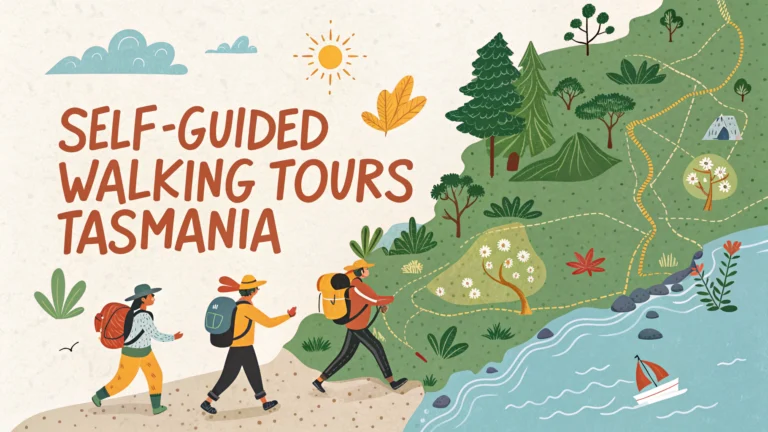Tasmania offers some of the world’s most scenic self-guided walking trails through ancient rainforests, along pristine coastlines, and across rugged mountains.
Popular Self-Guided Walking Routes
- Cradle Mountain Lake St Clair National Park
- Distance: 6-65km (various tracks)
- Difficulty: Easy to challenging
- Highlights: Ancient rainforests, alpine plateaus, wildlife
- Access fee: Parks pass required ($16.50/day)
- Freycinet Peninsula Circuit
- Distance: 30km circuit
- Duration: 2-3 days
- Highlights: Wineglass Bay, coastal scenery
- Best time: October-April
- Maria Island Walk
- Distance: Various day walks
- Access: Ferry from Triabunna ($45 return)
- Features: Historic ruins, wombats, pristine beaches
Essential Planning Tips
Book accommodation or camping permits through Tasmania Parks and Wildlife Service (parks.tas.gov.au) before starting multi-day walks.
Weather in Tasmania can change rapidly – pack warm layers and rain gear regardless of season.
Download offline maps through the Tasmania Parks app before heading out, as mobile coverage can be limited.
Safety Considerations
- Register your walk plans at visitor centers or online through PWS website
- Carry PLB (Personal Locator Beacon) for remote areas
- Check weather forecasts at Bureau of Meteorology
- Pack first aid kit and extra food/water
Recommended Equipment
| Essential Items | Optional Items |
|---|---|
|
– Waterproof jacket – Sturdy hiking boots – Navigation tools – First aid kit |
– Walking poles – Camera – Binoculars – Field guides |
Best Walking Seasons
Summer (December-February) offers the most stable weather conditions and longest daylight hours.
Spring (September-November) showcases wildflowers but can bring unpredictable weather.
Autumn (March-May) features stunning colors and fewer tourists.
Transport Options
- Shuttle services:
- McDermott’s Coaches: +61 3 6330 3717
- Tassielink: 1300 300 520
- Car rental available from Hobart and Launceston airports
Contact Tasmania Visitor Information Network (1800 990 440) for additional planning assistance and current track conditions.
Local Wildlife Encounters
Tasmania’s walking trails offer excellent opportunities to observe unique wildlife in their natural habitat. Maintain safe distances and never feed wild animals.
- Common Species
- Wombats (particularly active at dawn/dusk)
- Wallabies and pademelons
- Endemic bird species
- Tasmanian devils (rarely seen during day)
Trail Etiquette
- Stay on marked trails to protect vegetation
- Pack out all rubbish
- Use designated camping areas only
- Respect other walkers and wildlife
Food and Water
Carry sufficient water and water treatment methods. Most trails don’t have reliable water sources.
| Daily Requirements | Food Suggestions |
|---|---|
|
– 3L water minimum – Water treatment tablets – Filter system |
– High-energy snacks – Dehydrated meals – Emergency rations |
Conclusion
Tasmania’s self-guided walks provide world-class hiking experiences for all skill levels. Proper preparation, respect for the environment, and adherence to safety guidelines ensure an enjoyable and memorable adventure in this unique wilderness.
For current track conditions and updates, visit the Tasmania Parks and Wildlife Service website or contact local visitor centers before departing.
FAQs
- What are the best seasons for self-guided walking in Tasmania?
December to March offers the most stable weather, with warm days and long daylight hours. Spring (September-November) and Autumn (March-May) are also pleasant but pack for variable conditions. - Do I need permits for Tasmania’s walking tracks?
Yes, you need a Parks Pass to enter Tasmania’s national parks. For popular tracks like the Overland Track, you’ll need specific hiking permits during peak season (October-May). - Which are the most popular self-guided walking tracks in Tasmania?
The Overland Track, Three Capes Track, Freycinet Peninsula Circuit, Bay of Fires Walk, and Cradle Mountain Day Walks are among the most popular self-guided routes. - What essential gear should I pack for Tasmania’s walking tracks?
Waterproof jacket, layers of warm clothing, sturdy hiking boots, navigation tools (maps/GPS), first aid kit, water bottles, and emergency beacon (EPIRB) for remote tracks. - How difficult are Tasmania’s walking tracks?
Difficulty ranges from easy boardwalks to challenging wilderness trails. Grade 1-2 walks are suitable for beginners, while Grade 4-5 require advanced hiking experience and navigation skills. - What wildlife might I encounter on Tasmanian walking tracks?
Common encounters include wombats, wallabies, pademelons, echidnas, and various bird species. While rare, Tasmanian devils and quolls may be seen at dawn or dusk. - How long should I allow for major Tasmanian walking tracks?
The Overland Track typically takes 6-7 days, Three Capes Track 4 days, Freycinet Peninsula Circuit 3 days, and Bay of Fires Walk 4 days. - Is it safe to drink water from streams in Tasmania?
While Tasmania’s water is generally clean, it’s recommended to treat all water from natural sources. Carry water purification tablets or a filter system. - What accommodation options exist along walking tracks?
Options include public huts (basic), private huts (premium tracks), camping platforms, and designated campsites. Some tracks require advance bookings for accommodation. - How do I handle emergency situations on remote tracks?
Carry a Personal Locator Beacon (PLB), register your walk with parks authorities, maintain a detailed itinerary, and ensure your mobile phone is fully charged (though coverage is limited in remote areas).








